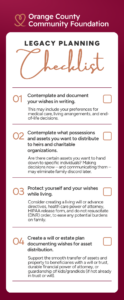Understanding the intricacies of legacy planning can be a daunting task. It includes more than naming beneficiaries for the material things you leave behind. It also includes documenting your wishes, in accordance with your values, for the lasting footprint of your lifetime. It’s about planning ahead with your loved ones in mind. The planning doesn’t all have to happen all at once. In fact, we suggest you start by contemplating your wishes and beginning conversations with your family to clarify your goals, hopes and vision.
Within this toolkit, you’ll find ten steps to ensure that your wishes are honored while you’re living and leave a loving legacy after you are gone.
STEP 1 – Contemplate and document your wishes in writing. This may include your preferences for medical care, living arrangements, and end-of-life decisions.
STEP 2 – Contemplate what possessions and assets you want to distribute to heirs and charitable organizations. Are there certain assets you want to hand down to specific individuals? Making decisions now – and communicating them – may eliminate family discord later.
STEP 3 – Protect yourself and your wishes while living. Losing the ability to make decisions for yourself while you’re alive can be tough on a family. Sudden incapacity can happen at any time. How will their family members act on your behalf? That process is much less agonizing if certain documents are in place such as a living will or advance directives, health care power of attorney, HIPAA release form, and do not resuscitate (DNR) order, if desired.
STEP 4 – Create a will or estate plan documenting wishes for asset distribution. Support the smooth transfer of assets and property to beneficiaries and avoid potential delays by creating a will or trust, durable financial power of attorney, or guardianship of kids/grandkids (if not already in trust or will)
STEP 5 – Assign beneficiaries to select assets. Assets like bank accounts, retirement funds, and life insurance, that are designated avoid probate as they have named beneficiaries or are titled in a way that allows them to pass directly to a specific person or entity upon your death.
STEP 6 – Write a legacy letter or ethical will. These are personal letters where you can share your values, experiences, and life lessons with your loved ones. You can also record them digitally.
STEP 7 – Establish a legacy fund. A charitable fund outlining your interest areas and nonprofit organizations will ensure your philanthropic intentions live on in the future.
STEP 8 – Organize your records and financial documents. Keep a record of all your financial assets, including bank accounts, investments, and insurance policies, making it easier for your loved ones to manage your finances. What else does your family need to know: your medications, your friends’ contact information, your insurance agent, passwords, and more.
STEP 9 – Communicate with loved ones. Discuss your plans and wishes with your family and close friends. This can help avoid confusion and conflict later on.
STEP 10 – Review and update documents regularly. Your wishes and circumstances may change over time (divorce, new births, etc.). Regularly review and update your documents to reflect these changes.
At the Orange County Community Foundation, we understand that each legacy is as unique as the individual behind it. Our team is ready to offer personalized support, tailoring our expertise to align with your vision and values. We are here to answer your questions, offer guidance, and ensure your legacy resonates with the causes you hold dear.
To learn more, please contact Margita Blattner, Sr. Director of Philanthropic Strategy at mblattner@oc-cf.org or 949-464-4510.





